Trailer Running Lights Not Working: 2023 Guide with Safety Tips
Are you having trouble with your trailer running lights not working? Don’t worry, this guide is here to assist you. We’ll cover common causes of trailer lights failure, walk you through diagnosing the issue, and provide essential safety tips for your trailer trips.
We have everything you need to fix your trailer running lights. Whether it’s a blown fuse, faulty wiring connection, or bulb problem. Let’s begin and solve it together!
Table of Contents
An Overview of the Trailer’s Running Lights
Trailer running lights are important for safety:
- They are usually found on the sides and rear of the trailer.
- These lights are always on when you connect the trailer to the towing vehicle.
- They help other drivers see the trailer better, especially in low-light situations.
- When trailer lights work they also show the size and position of the trailer on the road.
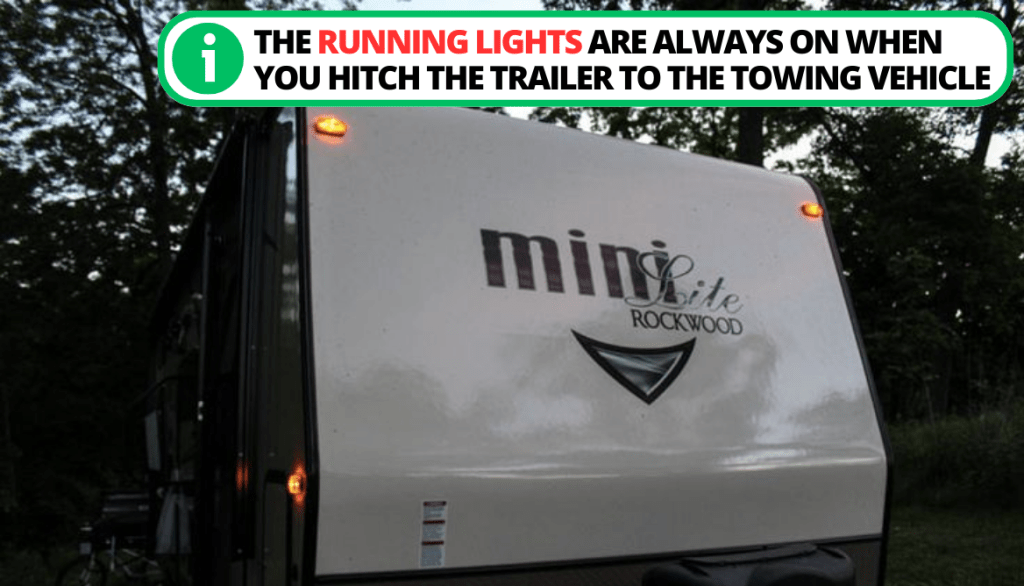
Types of Trailer Running Lights
There are many types of trailer running lights. They include:
- Side Marker Lights: These small trailer lights are located on the sides of the trailer and emit a steady white or amber light. They show the trailer’s width and presence to other drivers.
- Tail Lights: These red trailer lights are positioned at the rear to indicate the trailer’s presence and position, especially at night or when braking.
- Brake Lights: Brake lights shine brighter when the trailer’s brakes are applied. They alert drivers behind that the trailer is slowing down or stopping.
- Signal lights: The signal light is an important trailer light. The turn signals flash in a specific direction to signal the trailer’s intention to change lanes or turn.
- Clearance Lights: These small trailer lights are mounted higher on the trailer’s sides. They emit red light to indicate the trailer’s length and height, especially in low-light situations.
- License Plate Lights: These trailer lights illuminate the trailer’s license plate, ensuring it’s visible to others and meets legal requirements.
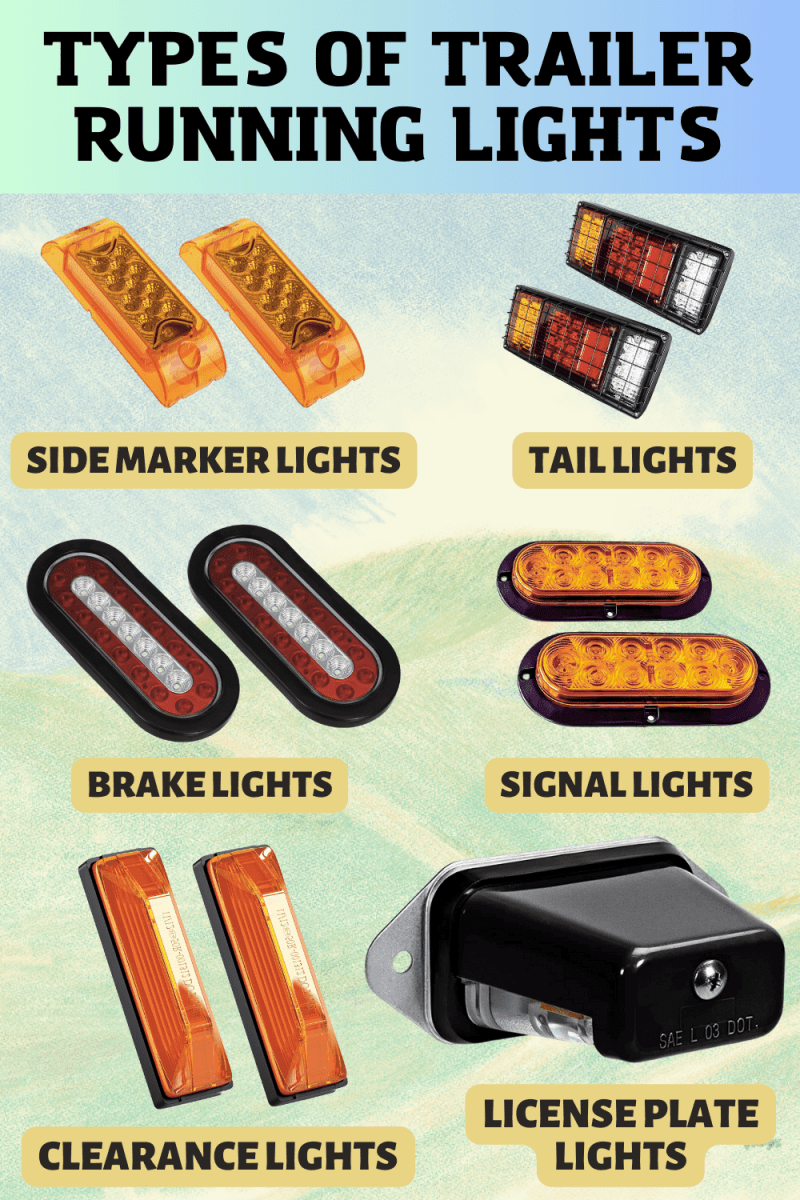
How to Fix Trailer Running Light Problems: Troubleshooting Handbook
Before diving into troubleshooting trailer running lights problems, it’s important to gather the necessary tools and materials. This will ensure a smooth solving process. Let’s now take a look at the list of required items.
Parts and Tools Required
To fix the trailer running lights not working, you will need the following:
- Pry bar: This tool is used to gently pry or remove components, such as covers or panels, during the troubleshooting or repair of trailer running lights not working.
- Test light: It’s a diagnostic tool that helps check for electrical power and connectivity. It is used to determine whether the trailer’s electrical circuits are functioning correctly and identify running light issues.
- Fuses: They protect electrical circuits from damage caused by overloading or short circuits.
- Wiring diagram: A visual representation or schematic that shows the electrical connections and paths in the trailer’s wiring system. It helps in understanding how the lights are wired and aids in diagnosing and repairing any issues.

To fix the trailer running lights not working, follow these steps:
1. Get a Wiring Diagram or Schematics
Get the wiring diagram or schematics for your trailer’s electrical system. You can find it either on the lid of the electrical box or on the manufacturer’s website. This will help you understand the circuitry and locate the relevant components.
2. Start the Vehicle and Step on the Brake Pedal
Follow these steps:
- Turn the key in the tow vehicle’s ignition to the “On” position.
- Press the brake pedal.
- Observe the trailer’s lights.
This step helps identify any potential issues related to the brake light circuit or any brake light bulbs installed.
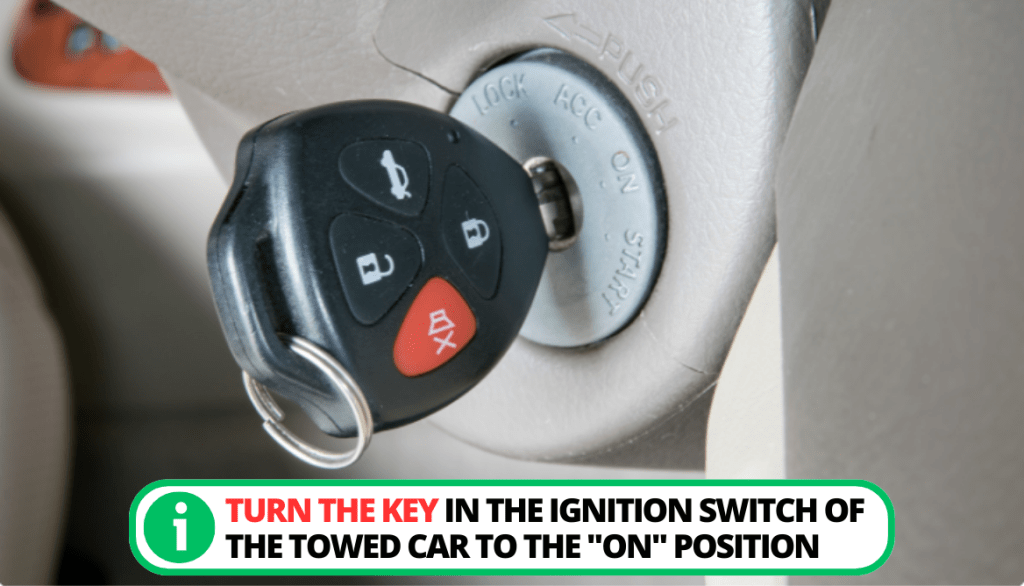
3. Inspect the Terminals for Corrosion
Examine the terminals of the trailer’s electrical connectors for any signs of corrosion. Corrosion blocks electricity and creates problems with the trailer lights. If corrosion is present, use a pry bar or a suitable tool to clean the terminals.
For more details on how to clean the terminals, you can watch this video.
4. Inspect the Connection Point for Signs of Corrosion
Inspect the trailer’s connector for any corrosion or damage. Rusty or broken connectors disrupt electrical connections and impact running light operation. Clean or replace the trailer connector if necessary.
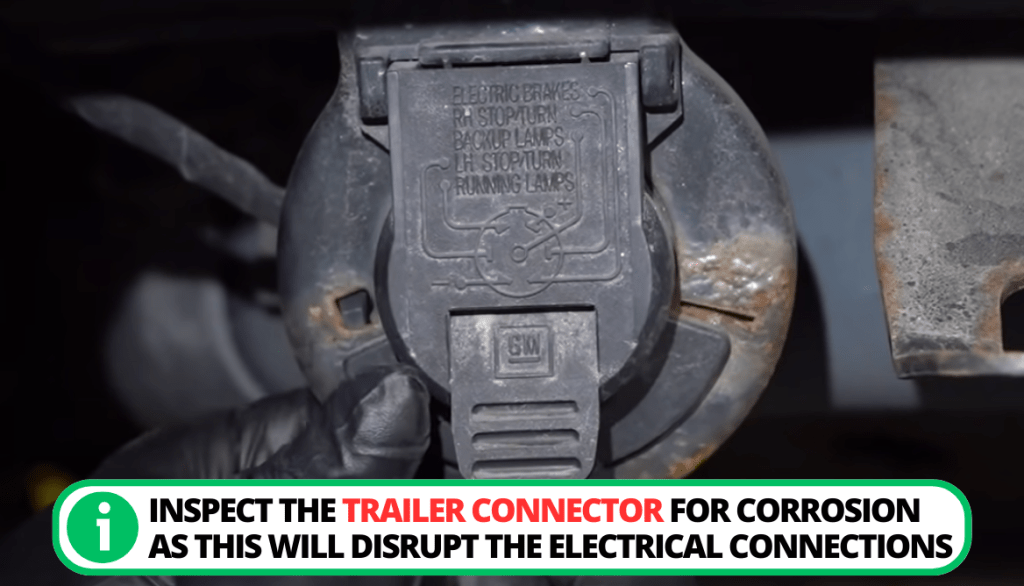
5. Verify the Fuses
Check the fuses related to the trailer’s lights. Use a test light to determine if the fuses have blown. If the test light indicates a blown one, replace it with a new one of the same rating. Make sure to use the appropriate fuse based on the trailer wiring diagram.
Here are some tips regarding the replacement of fuses:
- Look for any service bulletins specific to your vehicle regarding the fuses. Some manufacturers may provide specific instructions or precautions for replacing certain fuses.
- If you frequently need to replace fuses to restore the functionality of trailer lights, brake lights, and turn signals, there may be excessive load due to wiring or connector problems.
6. Test the Hitch Terminal After Replacing the Fuses
After replacing any blown fuses, test the hitch terminal for proper functionality:
- Connect the trailer to the tow vehicle and use a test light to check for power at the hitch terminal.
- Probe the terminal while the tow vehicle’s lights are turned on.
- If the test light indicates no power, there is a potential issue with the wiring or connection between the wire in the fuse box and the hitch terminal.

Guidelines on the Use of Trailer Running Lights
Guidelines regarding the use of trailer running lights are essential for ensuring safety on the road. These guidelines provide clear instructions on the use of rear lights, side lights, and wide trailers.
1. Guidelines Regarding the Use of Rear Lights
The rear lights of a trailer consist of brake lights, tail lights, license plate lights, and turn signal lights. Here are some guidelines regarding the use of rear lights:
- A pair of red functional brake lights should be connected correctly in the brake light system. This enables them to activate when the brakes are applied, alerting drivers behind.
- The license plate should be placed at the rear of the trailer. Ensure it has a license plate light on top of it for clear visibility.
- There should be a pair of sidelights on each side of the trailer. This helps other drivers see the vehicle when it’s dark or during low visibility conditions.
- A pair of red tail lights should be installed at the rear of the trailer. They should also be properly spaced to indicate the trailer’s width.
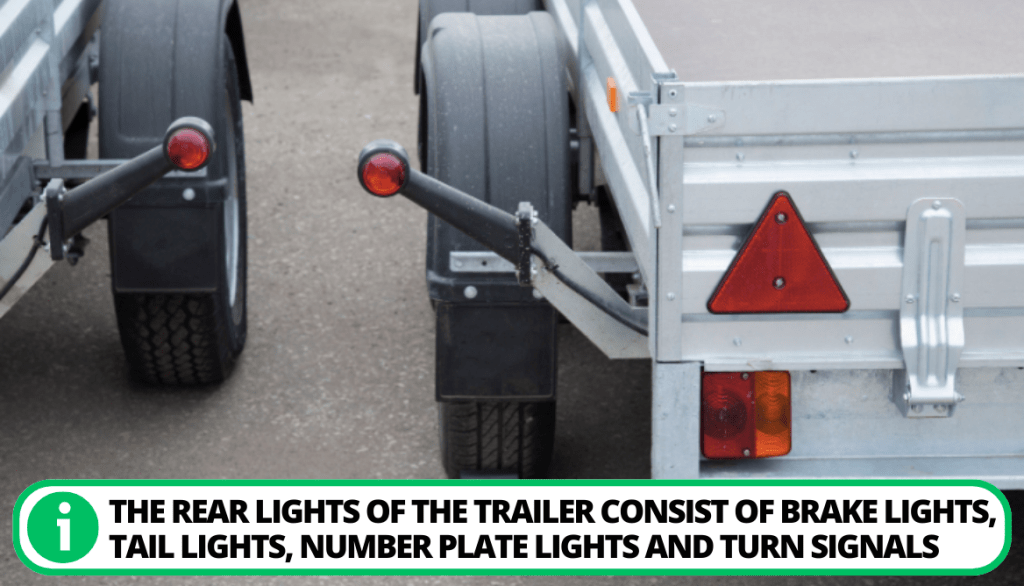
2. Guidelines Regarding the Use Of Side Light
Here are some guidelines to follow when using side lights:
- Front side lights should be yellow and about 15 inches above the ground. This helps enhance the visibility of the trailer to oncoming traffic.
- For trailers measuring 80 inches and above in width, it is recommended to include additional lights in the front and rear parts of the trailer. These lights enhance visibility and alert other drivers to the trailer’s size.
- Additional yellow sidelights should be used if the trailer exceeds 30 feet in length. These lights should also be positioned approximately 15 inches above the ground, aiding in visibility.
- Rear side lights should be red and positioned approximately 60 inches above the ground. This placement ensures they are visible to drivers behind the trailer.
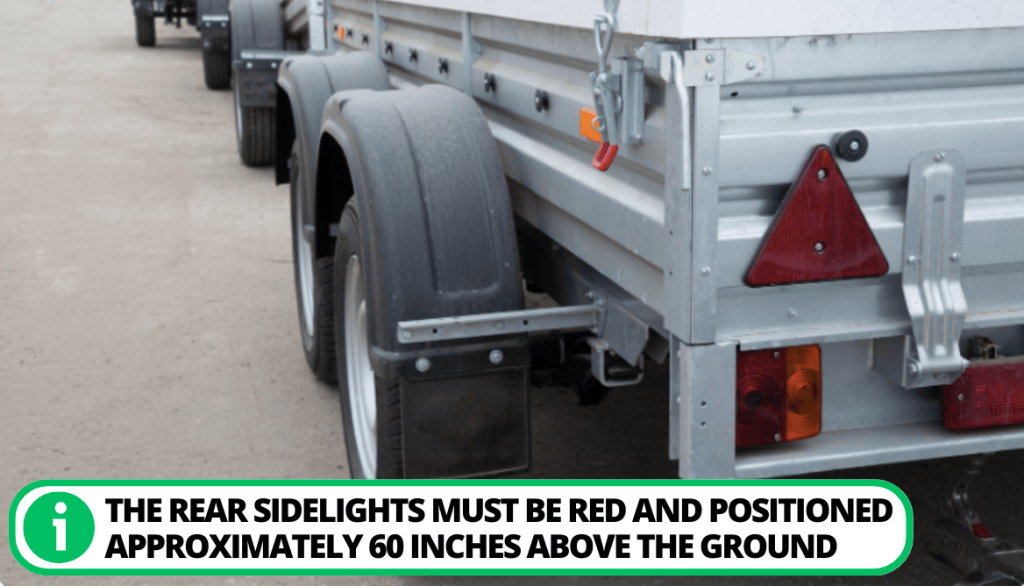
3. Guidelines Regarding the Use of a Wide Trailer
Here are some guidelines regarding the use of a wide trailer:
- When installing the identification lights, choose the highest part of the trailer’s rear.
- The front part of the wide trailer should have clearance lights at the highest and nearest point to the front.
- Wide trailers should be fitted with permanent trailer lights.
- Red clearance lights should be placed at the rear part of the wide trailer at the widest and highest point possible.
- Three red identification lights should be mounted in the wide trailer’s rear position. These lights should be placed in the center with 6 to 12 inches of spacing between them.
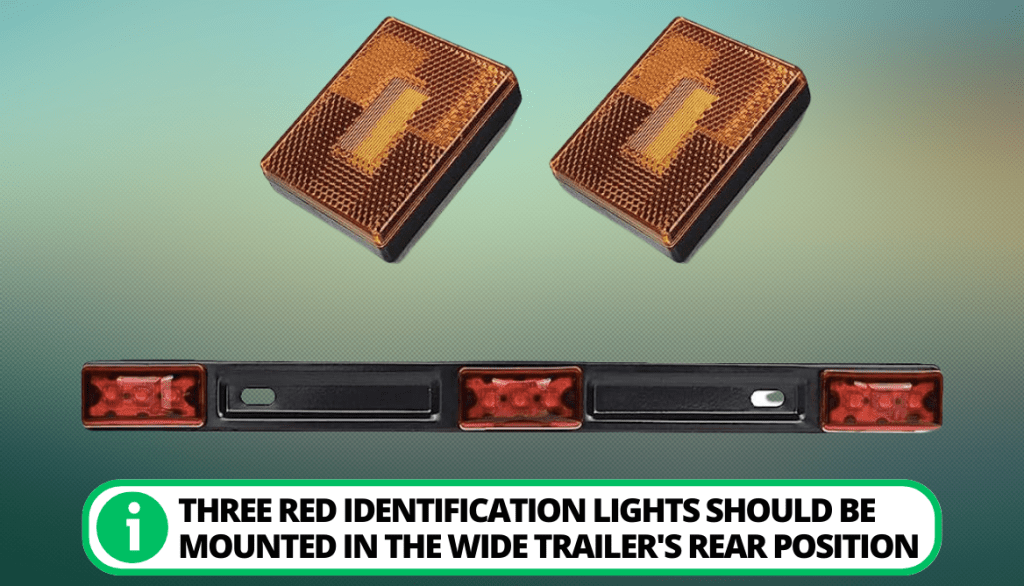
4. General Guidelines for All Trailer Lights
Some of the general guidelines for all the lights include:
- Trailer lights should be in good working condition before the trailer is used. Regularly check and replace any bulbs that are burnt out.
- Trailer lights should be clean and free from dirt, dust, or other debris that may obstruct their visibility.
- Trailer lights should be securely fastened to the trailer to prevent them from becoming loose or falling off during transportation.
- Use weatherproof and durable light fixtures to withstand different weather conditions and protect the electrical connections.
- Regularly inspect all the wires for any signs of damage or corrosion. Repair or replace all the wires that are damaged to maintain the proper functioning of the trailer lights.
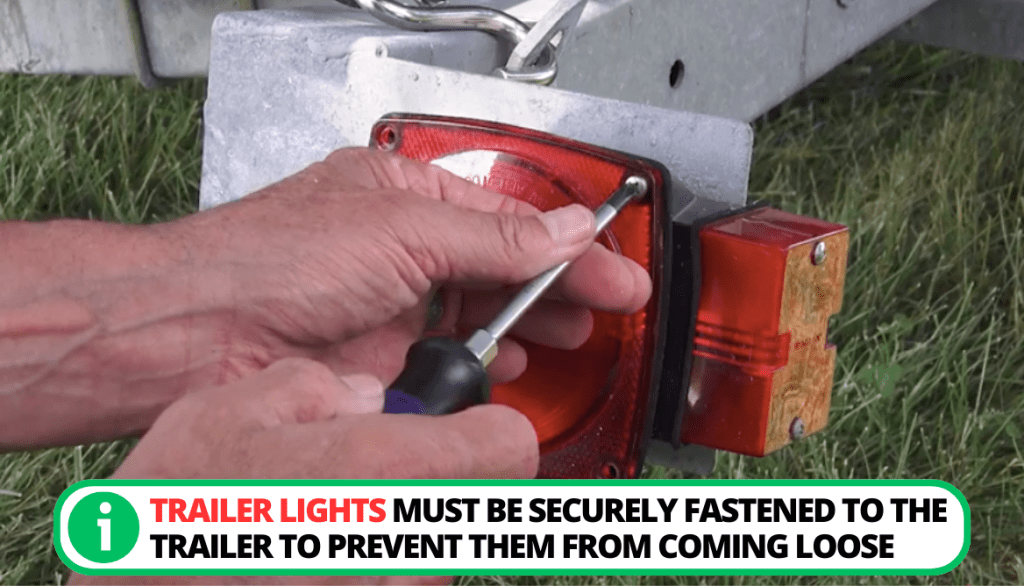
Safety Tips When Driving a Trailer
When it comes to driving a trailer, safety should be your top priority. Here are some handy tips to keep in mind:
1. Maintain a Safe Distance
When towing a trailer, keep a greater distance between your vehicle and the vehicle ahead. This allows for increased stopping distance and helps prevent accidents.
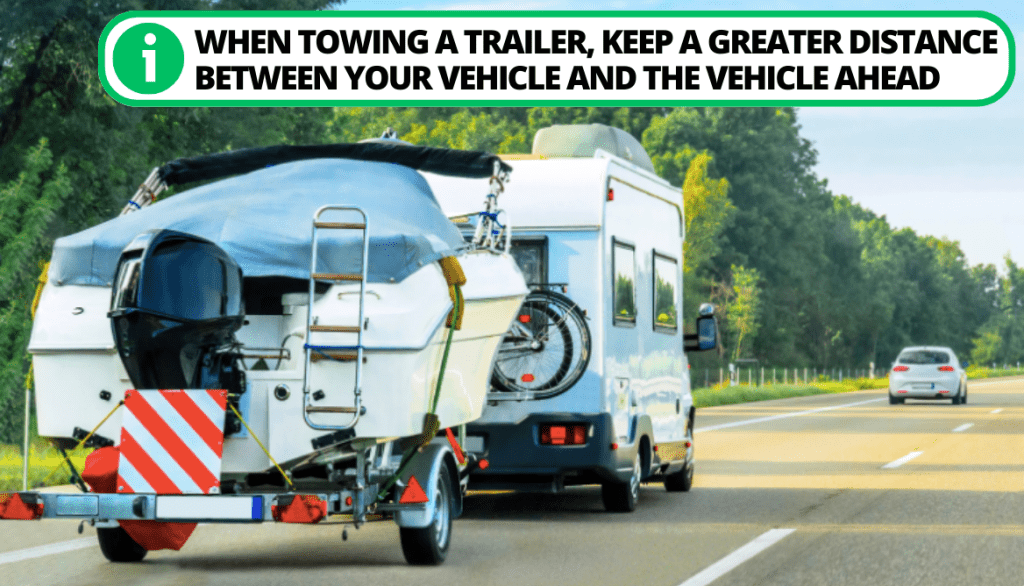
2. Slow and Steady Wins the Race
When towing a trailer, remember to drive at a moderate speed. Avoid sudden maneuvers and give yourself plenty of time to brake and make turns.
3. Watch Your Blind Spots
Trailers can create larger blind spots, so be extra cautious when changing lanes or merging. Use your mirrors and consider installing additional towing mirrors for better visibility. Also, remember to use your turn signals to indicate your intentions to other drivers on the road.
4. Secure Your Load
Before hitting the road, double-check that your trailer’s cargo is properly secured. Loose items can shift during transit and affect the stability of your trailer.
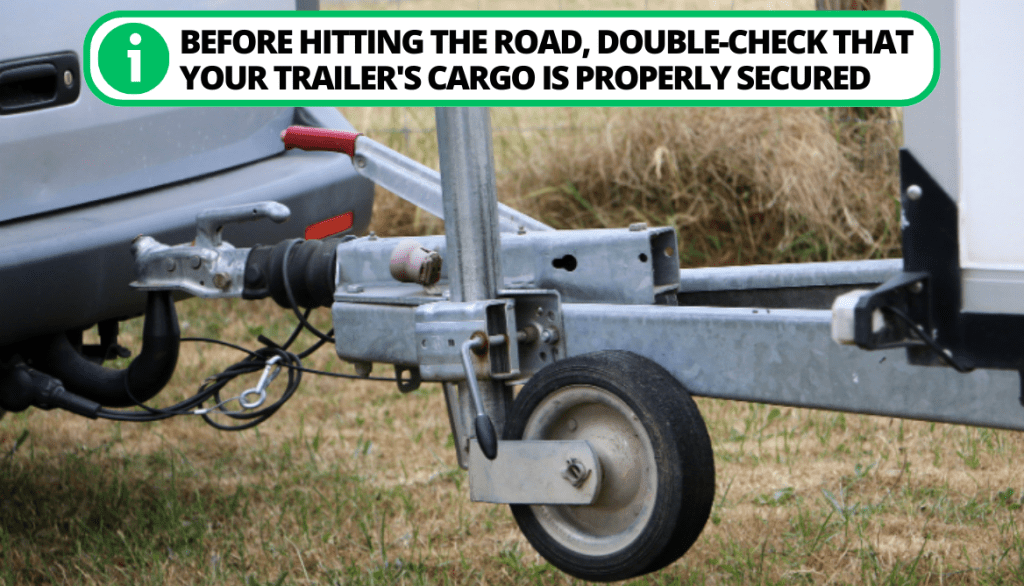
5. Check Tire Pressure
Regularly inspect the tire pressure of both your towing vehicle and trailer. Properly inflated tires provide better control and reduce the risk of blowouts.
6. Take Wide Turns
Due to the extended length of a trailer, make wide turns to avoid clipping curbs or other obstacles. Give yourself ample space to maneuver and use turn signals well in advance.
7. Be Mindful of Weight Distribution
Ensure that your trailer is properly loaded with weight distributed evenly. Improper weight distribution can affect handling and stability.
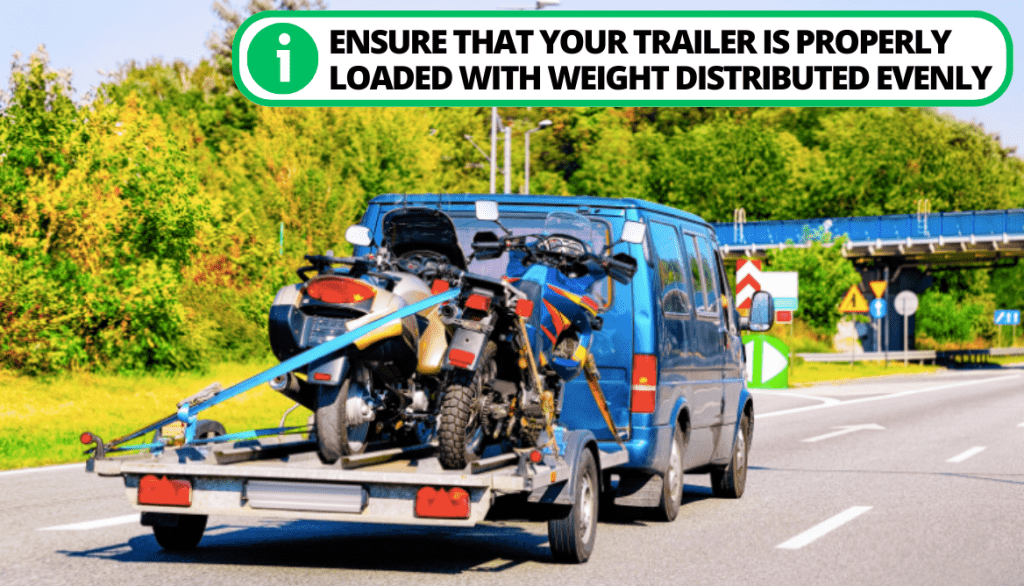
8. Practice Backing Up
Backing up with a trailer can be tricky. Find an empty parking lot or open area to practice maneuvering in reverse until you feel comfortable.
9. Be Alert and Patient
Stay focused on the road and avoid distractions. Remember that towing a trailer requires extra attention and patience. Stay calm and make calculated decisions, including using each signal light correctly to communicate your intentions to other drivers.
10. Get Familiar with Trailer Brakes
If your trailer is equipped with brakes, familiarize yourself with their operation. Adjust the brake controller to ensure optimal braking performance.

FAQ
Why Is My Running Lights Not Working On My Trailer?
If your trailer’s running lights are not functioning, the problem is often due to a blown fuse, faulty wiring connections, or a burned-out bulb. To address this issue, check the fuse box, examine the trailer’s wiring connections, and replace any defective bulbs. Additionally, consider replacing all traditional lights with LED lights as they have a longer lifespan.
Why Do My Brake Lights Work but Not My Running Lights?
If your brake lights are working, but the trailer running lights not working, it is likely due to a separate circuit or wiring issue. Inspect the wiring harness and connections for any damage or lose connections. Additionally, check the light switch and relay related to the running lights.
Why Are the Running Lights Not Working On My Truck?
When the running lights on your truck are not functioning, it could be due to blown fuses, a faulty switch, or damaged wiring. Start by checking the fuse box for any blown fuses. If the fuses are intact, inspect the light switch and wiring connections for any issues.
Conclusion
Trailer running lights not working due to a blown fuse, faulty wiring connection, or bulb problem can be frustrating. To fix this, you need to replace blown fuses and bulbs, and inspect the terminals and connection points for corrosion. However, if these steps do not rectify the issue, it is advisable to seek assistance from a professional.
Have you ever encountered any problems with your trailer running lights? Please share your experiences and let us know how this guide has helped you in resolving the issue.

I`m a current Law Enforcement Officer working within the Counterterrorism Bureau in New York State. I have been Camping for over 20 years. My styles of camping include tent, car, truck, van, and RV travel trailer. I have a YouTube channel where I teach all types of camping with an entertaining method: https://youtube.com/@TheSmallsRVAdventures






